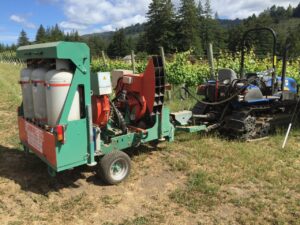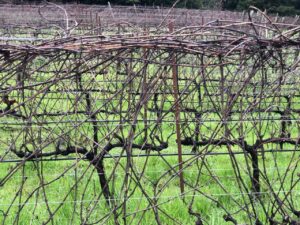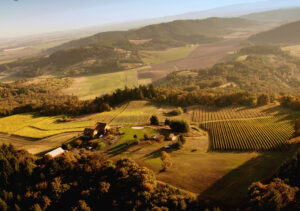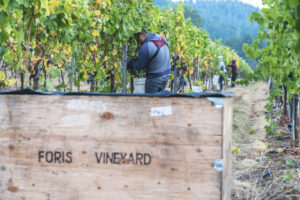Winemakers Weigh in with Tips and Strategies for Vineyard Success
On the Edge of the Pacific Ocean
By Laura Ness
It’s no secret that growing grapes within the reach of the Pacific Ocean — whether you’re in the Santa Cruz Mountains, on the Sonoma Coast or up north in Oregon — can make one go gray early. But, say winemakers who’ve embraced this challenge, it’s well worth the travails. Here are some tips to ease the pain. They won’t work for everyone, but if you’re not afraid of a little heat, read on.
Heat and yeast
James Schultze, proprietor/winemaker of Windy Oaks Estate in the Corralitos area of California’s Santa Cruz Mountains, faces constant fog pressure. His secret weapon is “Le Chaud,” his French nickname for “The Heat,” a machine he began using in 2016 throughout his 18-acre vineyard for mealybug control . Made by Agrothermal, it’s basically a giant heat-blowing fan towed behind a tractor (the hot air kills mealybugs on contact).

“I have one really steep block where I am too nervous to use the machine, and it’s the only place we found mealybugs,” says Schultze. It’s also miraculous at eradicating mildew. He has reduced his number of sprays to four per season. “I use [Le Chaud] on the whole vineyard to control botrytis and mealybugs and I have zero botrytis.”
An additional benefit, he says, is wine flavor: “I did a control block and a heat-treated block and had them tested by ETS. The heat-treated grapes had 50% higher phenolics — mind blowing! That explains why the wine tastes the way it does.”
The machine is a lifesaver during pre-harvest rain events. “I can make almost three passes through the vineyard if the tanks start out full. Even at current high prices for propane of about $4.50 per gallon, that’s a bit less than $125 per pass. A single spray is typically two to three times that, sometimes more.”
Another challenge in coastal vineyards, who hasn’t struggled with VA? Schultze says he learned a trick while attending a seminar in Burgundy. Use Zymaflore AlphaTD, a non-Saccharomyces yeast that’s intolerant of alcohol, to get rid of spoilage bacteria. “When picking up bins from other vineyards or bringing in my own, I sprinkle the freeze-dried yeast over the grapes. It’s activated by humidity and dies once fermentation starts.” You can still do cold soaks and not worry about VA, he says —and you can still do native yeast fermentation. “There is no downside here!” While it costs twice as much as saccharomyces yeast, you use very little.

Another trick he learned from attending seminars in France was to eliminate hedging in favor of vine-top spreaders that are used at premier estates in Burgundy. “Madame Lalou Bize-Leroy felt that cutting growing shoots creates a negative hormonal response that impacts flavors and reduces complexity.” On this advice, Schultze tried one block with wider top spreaders on the vine posts to open the canopy and reduce side shoots. He loved it so much he retrofitted his entire vineyard.
Another simple trick: use solo cups to prevent netting from getting caught on the line posts. “If you’re careful you can reuse netting,” says Schultze. “We still have original netting from 1999. Our white netting seems to have lasted longest. It’s interesting, a study was done by NZ University looking at different colors of netting, and it found that white helps with ripening and sugar levels.”
Mildew and insect control
Schultze learned of the Agrothermal machine from Kurt Gollnick, who was head of viticulture and COO at Scheid Vineyards until 2022. Gollnick, now of Rodnick Farms in the Chalone AVA, says of his longtime employer using Agrothermal machines, “I believe it aided in early season mildew suppression and helped activate the organic Stylet oil that was the mainstay of the organic acreage.”
He continues, “Additionally, we saw a measurable difference in fruit set during cool springs as determined by seed count. The heat-treated blocks had berries with higher average numbers of seeds per berry, which translates to higher berry weights. Most important, the berry skins in red fruit seemed to thicken and be a little tougher if we stayed on 7-day intervals from lag phase through veraison. That’s four to five passes during a critical period. The flavors from the resulting wines seemed more fruit forward and a little more concentrated — overall a good experience.”
Gollnick has two Agrothermal rigs on his 30-acre Rodnick Farm, where he grows premium grapes, mostly for sale. He says it might not be appropriate for large production programs with wines below $20 per bottle, but, “Artisan winemakers, such as Jim Schultze or Bradley Brown, can handle these high-end grapes and squeeze the value from their wines.”
The heat machines can also help with insect control, which is quite helpful for organic farming, he confirms. “You really have to be on your game to leverage the Agrothermal applications,” cautions Gollnick. “If you’re out of sync, there is little benefit.”
Apparently, not everyone has the appetite for such hot technology. (Note: Agrothermal recently shuttered its office in Napa.)
More coastal viewpoints

Wayne Bailey of Youngberg Hill, in the coastal foothills of Oregon’s McMinnville AVA, says getting enough heat to fully ripen fruit pushes harvest into late fall and challenges vine vigor. “Fruit set has not been an issue, because we tend to bloom later, when the weather is more favorable. As an organic farmer, we have focused on shorter intervals of spraying oil, sulfur and whey to protect the vines.” Over the years, he’s had to encourage a little more canopy for shade, do less hedging and shorten spray intervals.
It’s been 44 years since Ted Gerber, founder of Foris Wines in Cave Junction, Ore., planted his first cool climate grapes (Gewürztraminer and Pinot Noir), on a former Christmas tree farm. With 255 acres now planted, his biggest problems are labor availability and occasional pests, such as leaf hoppers.

Although frost was the major challenge back in 1974, it’s become less of an issue, he says, with 2023 so far requiring the least frost protection yet needed: one night versus an average of five. What’s more, he says, “Hedging used to be a hand swung Christmas tree knife; today, it’s a double row Clemens tractor implement. Leaf stripping is also done via Clemens machine, instead of a big manual labor force. ATVs have helped lower tractor costs and maintenance.” Asked if he has an EV tractor, he says, “I’m waiting for the hydrogen model.”
Andy Peay, his brother Nick, and his winemaker sister-in-law, Vanessa Wong, farm Pinot Noir, Chardonnay and Syrah organically for Peay Vineyards on the extreme Sonoma Coast (in the not-really-a-town of Annapolis), just four miles from the Pacific. A constant challenge in the face of fog and wind is fruit set and yield. Clusters and berries are tiny, he says: “We are averaging 1.6 to 1.7 tons per acre.”
Dealing with the extremes of the weather, like the torrid heat wave of 2022, has become his biggest nightmare. “One of the benefits of older vineyards is that they can handle heat. They shut down and go into panic mode.” Having the same winemaker for 20 years is another big advantage. “In the easy vintages, you have the leeway to wait a day or two. But great winemakers show up in hard vintages. They know when to pick certain blocks — and now means now.”
Picking fruit on-demand and getting clean fruit in a heatwave-free year, when autumn rot is prevalent, wouldn’t be possible without a dedicated labor force. For Peay, having H2 Visa workers is a lifesaver, as his original crew from 1999 moved closer to civilization to raise families over the years. Most now work in construction. But, he says, beautifully aromatic, graceful wine that could only come from a maritime clime is the reward. “2022 was the hardest harvest ever, but the Pinot Noir will be excellent.”
In a nutshell, heat is great — when you can control it. And given the way this growing season is going, some heat will be welcome, especially in coastal vineyards where the fog is more prolific than ever. Moderation seems a coveted, and increasingly scarce, commodity.
__________________________________________________________________
![Laura Ness [Duncan Garrett Photography]](https://wineindustryadvisor.com/wp-content/uploads/2023/04/9C1A4064-300x200.jpg)
Laura Ness
Laura Ness is an avid wine journalist, storyteller and wine columnist (Edible:Monterey, Los Gatos Magazine San Jose Mercury News, The Livermore Independent), and a long time contributor to Wine Industry Network. Known as “HerVineNess,” she judges wine competitions throughout California and has a corkscrew in every purse. However, she wishes that all wineries would adopt screwcaps!




